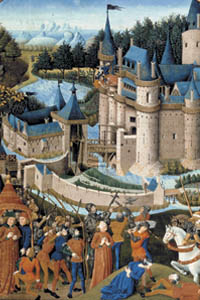Distant as it may seem, medieval warfare gave us numerous terms that remain in our vocabulary. One of the first that comes to mind is Crusade, the name given to a series of Christian military expeditions in the 11th, 12th, and 13th centuries to recover the Holy Land from Muslims. Actually the word “crusade,” derived from Latin and French words for “cross,” was not used for these expeditions until the 16th century. Since that time, the capitalized noun has been applied to these medieval expeditions, but the lowercase form was expanded to mean any concerted movement for a cause or against an abuse.
From the time of the First Crusade, proclaimed by Pope Urban II on November 27, 1095, one major aspect of warfare was the surrounding and blockading of a town or fort to cut off and capture it. The tactic became known as a siege in the 1300s, and it has since entered everyday vocabulary to mean a prolonged period of some kind, such as a siege of illness or a siege of bad weather.
To withstand attack, a town or castle was frequently heavily walled. To gain access the attackers often used a belfry, a movable siege tower. A tall structure on a wheeled framed base, it was fitted with a pivoting ramp at the top that could be swung down on top of the wall so attackers could fight their way in. Since the 15th century this noun has signified a bell tower, generally attached to a church or other building but sometimes freestanding. The term is also used for the room or church tower in which the bells are hung.
The commander of a medieval town or garrison was called a constable, a high official. In civilian life, however, the constable became an officer of lower rank than a sheriff (and in Britain simply an ordinary policeman).
Medieval rulers often built castles sequentially as they claimed territory. For example, in the late 13th century King Edward I of England built a row of castles from Caernarfon to Conwy to Harlech to secure his conquests in northern Wales. To better protect against sieges, castle construction became more and more elaborate. Castles were sometimes surrounded by a protective moat as well as by earthen embankments called ramparts. Today moats are used for such purposes as separating the animals in a zoo from visitors. By the mid-16th century the noun “rampart” was being used to signify other barriers, such as a shoreline embankment between land and sea, as well as figuratively, for a barrier of any kind. For example: “They crash through the thickest ramparts of politeness” (American Mercury, October 1928).
To give access to the castle entrance over the moat, there usually was a drawbridge, a device still used today to allow the passage of tall vessels. The raising mechanism commonly used counterweights to assist the downpull and speed the lift. In effect, this was a pioneering use of gravity as applied energy. The drawbridge was often combined with a portcullis, or sliding gate, a grating of heavy timber or iron set in stone channels on either side of the main castle entrance. It could be quickly lowered to prevent any entry before the drawbridge was raised.
Sometimes ramparts were topped with wooden palisades, rows of timber uprights. This term has been transferred to a line of steep cliffs, often above a river. The Palisades over the Hudson in New Jersey is a prime example.
European military action was not the only conflict of the Middle Ages. From 1202 to 1227, the Mongol warrior Genghis Khan united Turkic and Mongol tribes and overran much of Asia and Eastern Europe. One such tribe was the Tartars, and their name survives in the epithet tartar, for a ferocious or violent individual. It is also referred to in the idiom to catch a Tartar, meaning to seek out something or someone who turns out to be unexpectedly unpleasant or formidable.
The term mercenary, meaning a soldier employed in a foreign army, dates from the 16th century. Earlier it had simply meant anyone hired purely for financial or other material gain, but then it was applied to troops so employed. The term survives in its military meaning, but it is also used as an adjective describing a course of action or its motivation impelled by self-interest or undertaken only for personal gain. By extension mercenary behavior is generally considered unethical.
Christine Ammer has written several dozen wordbooks. The newest is Facts on File Dictionary of Clichés, 3rd edition.


